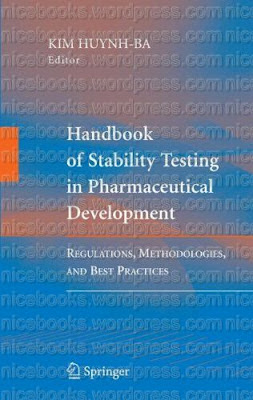Essentials of Pharmaceutical Chemistry, 3rd Edition
 It covers the core information required by pharmacy students to understand the action of modern
It covers the core information required by pharmacy students to understand the action of modern Download
Protein Formulation and Delivery
 This handy reference provides insight into the approach used to identify the stability profile of a molecule that comes at the end of the drug registration process, and supplies an in-depth review of the mechanisms and associated causes of
This handy reference provides insight into the approach used to identify the stability profile of a molecule that comes at the end of the drug registration process, and supplies an in-depth review of the mechanisms and associated causes of Download
Impurities Evaluation of Pharmaceuticals
 Filling a gap in the pharmaceutical literature, this unique guide addresses the development of targeted methodologies to monitor impurities in pharmaceutical compounds and drug products. Furnishes physicochemical protocols to determine the purity of pharmaceutical compounds fully before pharmacological and toxicological studies begin! Providing a clear definition of the subject, Impurities Evaluation of Pharmaceuticals introduces various techniques for isolating and characterizing impurities presents guidelines to evaluate stability using kinetic studies shows how to develop stability-indicating methodologies details various methods that require minimal sample prepreparation gives regulatory perspectives on chiral impurities and more! Containing important literature citations and offering an invaluable list of applications, Impurities Evaluation of Pharmaceuticals is an outstanding resource for pharmacists and pharmacologists, clinical microbiologists, quality assurance and production managers in the pharmaceutical industry, analytical chemists and biochemists, pharmaceutical regulatory personnel, and upper-level undergraduate, graduate, and continuing-education students in these disciplines.
Filling a gap in the pharmaceutical literature, this unique guide addresses the development of targeted methodologies to monitor impurities in pharmaceutical compounds and drug products. Furnishes physicochemical protocols to determine the purity of pharmaceutical compounds fully before pharmacological and toxicological studies begin! Providing a clear definition of the subject, Impurities Evaluation of Pharmaceuticals introduces various techniques for isolating and characterizing impurities presents guidelines to evaluate stability using kinetic studies shows how to develop stability-indicating methodologies details various methods that require minimal sample prepreparation gives regulatory perspectives on chiral impurities and more! Containing important literature citations and offering an invaluable list of applications, Impurities Evaluation of Pharmaceuticals is an outstanding resource for pharmacists and pharmacologists, clinical microbiologists, quality assurance and production managers in the pharmaceutical industry, analytical chemists and biochemists, pharmaceutical regulatory personnel, and upper-level undergraduate, graduate, and continuing-education students in these disciplines.Download
Robustness of Analytical Chemical Methods and Pharmaceutical Technological Products
 Hardbound. In analytical chemistry and pharmaceutical technology attention is increasingly focussed on improving the quality of methods and products. This book aims at fostering the awareness of the potential of existing mathematical and statistical methods to improve this quality. It provides procedures and ideas on how to make a product or a method less sensitive to small variations in influencing factors. Major issues covered are robustness and stability improvement and ruggedness testing. General strategies and a theoretical introduction to these methods are described, and thorough overviews of methods used in both application areas and descriptions of practical applications are given.
Hardbound. In analytical chemistry and pharmaceutical technology attention is increasingly focussed on improving the quality of methods and products. This book aims at fostering the awareness of the potential of existing mathematical and statistical methods to improve this quality. It provides procedures and ideas on how to make a product or a method less sensitive to small variations in influencing factors. Major issues covered are robustness and stability improvement and ruggedness testing. General strategies and a theoretical introduction to these methods are described, and thorough overviews of methods used in both application areas and descriptions of practical applications are given.Features of this book:
• Gives a good overview of mathematical and statistical methods used in two application areas, i.e. pharmaceutical technology and analytical chemistry
• Illustrates the different approaches available to attain robustness
Handbook of Stability Testing in Pharmaceutical Development: Regulations, Methodologies, and Best Practices
Stability testing is required to demonstrate that a pharmaceutical product meets its acceptance criteria throughout its shelf life and to gain regulatory approval for commercialization. Assessing drug product stability and safety can be quite complicated, and stability profile can impact many functional areas, including analytical testing, formulation development, toxicology, quality, and regulatory affairs.
Handbook of Stability Testing in Pharmaceutical Development: Regulations, Methodologies, and Best Practices is the first volume to cover all aspects of stability testing in pharmaceutical development. It presents a scientific understanding of regulations and balances methodologies and best practices. Comprising 17 chapters, it provides a wealth of resources for pharmaceutical companies, educational institutions, and manufacturing laboratories to use as either a supplementary text for stability training courses or as a reference book for pharmaceutical practitioners.
Topics covered include:
- Latest regulations for stability testing, including cGMP requirements, ICH guidelines, and global guidances from WHO, ASEAN, EMRO, and other regions.
- Post-approval considerations and regulatory filing strategies to support a global supply chain.
- Methodologies, including development of a stability-indicating method, method validation, and transfer. This book also discusses physical stability, non-chromatographic methodologies, and spectroscopic applications.
- Setting specifications, monitoring impurities, and establishing shelf-life of pharmaceutical products.
- Data management, including stability reports, CMC, and discussion of out-of-specification (OOS) and out-of-trend (OOT).
- USP-NF testing in support of stability.
- Current industry best practices on stability operation, validation, and calibration of stability chambers including considerations for photo-stability testing.
- Discussion of matrixing and bracketing to support reduced stability testing.
- Overview of stability programs for biologics and drug-in-devices pharmaceutical products.
This collective work was written by a group of prominent international experts, who have been directly responsible for instituting industry best practices and establishing the current stability guidelines.
Statistical Design and Analysis of Stability Studies
 The US Food and Drug Administration's Report to the Nation in 2004 and 2005 indicated that one of the top reasons for drug recall was that stability data did not support existing expiration dates. Pharmaceutical companies conduct stability studies to characterize the degradation of drug products and to estimate drug shelf life. Illustrating how stability studies play an important role in drug safety and quality assurance, Statistical Design and Analysis of Stability Studies presents the principles and methodologies in the design and analysis of stability studies. After introducing the basic concepts of stability testing, the book focuses on short-term stability studies and reviews several methods for estimating drug expiration dating periods. It then compares some commonly employed study designs and discusses both fixed and random batch statistical analyses. Following a chapter on the statistical methods for stability analysis under a linear mixed effects model, the book examines stability analyses with discrete responses, multiple components, and frozen drug products. In addition, the author provides statistical methods for dissolution testing and explores current issues and recent developments in stability studies. To ensure the safety of consumers, professionals in the field must carry out stability studies to determine the reliability of drug products during their expiration period. This book provides the material necessary for you to perform stability designs and analyses in pharmaceutical research and development.
The US Food and Drug Administration's Report to the Nation in 2004 and 2005 indicated that one of the top reasons for drug recall was that stability data did not support existing expiration dates. Pharmaceutical companies conduct stability studies to characterize the degradation of drug products and to estimate drug shelf life. Illustrating how stability studies play an important role in drug safety and quality assurance, Statistical Design and Analysis of Stability Studies presents the principles and methodologies in the design and analysis of stability studies. After introducing the basic concepts of stability testing, the book focuses on short-term stability studies and reviews several methods for estimating drug expiration dating periods. It then compares some commonly employed study designs and discusses both fixed and random batch statistical analyses. Following a chapter on the statistical methods for stability analysis under a linear mixed effects model, the book examines stability analyses with discrete responses, multiple components, and frozen drug products. In addition, the author provides statistical methods for dissolution testing and explores current issues and recent developments in stability studies. To ensure the safety of consumers, professionals in the field must carry out stability studies to determine the reliability of drug products during their expiration period. This book provides the material necessary for you to perform stability designs and analyses in pharmaceutical research and development.Download
Stability of Drugs and Dosage Forms
 Drug products are complex mixtures of drugs and excipients and, as such, their chemical and physical stability kinetics are complex. This book discusses the stability of these dosage forms with preformulation studies through to the studies on the final products. The book is intended for graduate students, researchers and professionals in the field of Pharmaceutics and Pharmaceutical Chemistry.
Drug products are complex mixtures of drugs and excipients and, as such, their chemical and physical stability kinetics are complex. This book discusses the stability of these dosage forms with preformulation studies through to the studies on the final products. The book is intended for graduate students, researchers and professionals in the field of Pharmaceutics and Pharmaceutical Chemistry.http://rapidshare.com/files/50694531/stability_drugs_dosage_forms.zip
Drug Stability: Principles and Practices

Addressing concerns for patient welfare while protecting producer reputation, and providing a database for formulation of other products, this multiauthored reference blends fundamental theory and practical advice on drug product stability in scientific, technical, and regulatory environments, covering development of indicating assays, computer use,
Download Link:
http://rapidshare.com/files/44693735/drug_stability.zip




0 comments:
Post a Comment